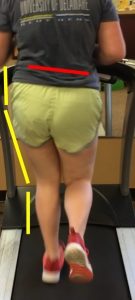Collapsing
In my last post, we discussed the idea of a collapsing runner. This is someone who either shows a Trendelenberg in the stance phase of gait, or collapses inward at the knee through hip internal rotation and adduction. This is common with runners experiencing knee pain.
Many times I find the typical prescription is hip strengthening. It makes perfect sense. The hip abductors and external rotators do not possess enough strength to control the collapse. Many runners will see improved pain levels with this plan, but it is also important to realize that many runners may have a reoccurrence of the pain at a later time. Is it possible that one of the reasons your runner improved is partially due to the time they likely spent reducing their running volume while in rehab?
Here’s the thing. Just because you improve a runner’s hip strength does not mean his/her running gait will change.² If running brought on the pain and we’re not fixing the running mechanics, then we’re addressing only half the problem!
With that said if you’re not fixing the strength deficits, your ability to fix the running likely may also not be successful. It is vitally important to know whether your fix needs to be aimed at mobility, motor control, strength, or a running technique impairment. I use the ACE Running Movement and Stability Screen then perform a running gait analysis to determine what area(s) I should be addressing.
Once there is adequate mobility, strength, and pain is under control, it is imperative that we move a step past just strengthening and perform gait retraining. There are many ways to accomplish this. Just a few options are:
1. Biofeedback: I use Trace 3D motion capture, but you can also use a mirror or another form of biofeedback to cue the patient
2. Provide verbal cues, such as, “pretend there are flashlights on your knees, and point them straight ahead”
3. Manipulate Cadence
Cadence
We’re going to focus on manipulating cadence. Many runners demonstrate a slower than ideal cadence. If you’re unfamiliar with cadence, it refers to the number of foot strikes over a 1 minute time period. It can be calculated by counting the steps a runner takes or instantaneously provided by many running watches. The runner pictured was running at 155 steps per minute, which is extremely low, even for a 10 minute mile pace. Some suggestions when manipulating cadence discuss the ideal number is 180 steps per minute, but it is important to realize the cadence for a 12 minute mile and a 6 minute mile are much different! Instead of assuming a set number, make a goal of increasing cadence 5-10%. This has been shown to reduce the collapsing nature shown in these runners and can be a great 1st step in helping on the road to recovery.¹
Looking for more on identifying and correcting running issues?
ACE Running Certified Gait Analyst
1. Heiderscheit, B. C., Chumanov, E. S., Michalski, M. P., Wille, C. M., & Ryan, M. B. (2011). Effects of step rate manipulation on joint mechanics during running. Medicine and Science in Sports and Exercise, 43(2), 296–302.
2. Willy RW, Davis IS. The effect of a hip-strengthening program on mechanics during running and during a single-leg squat. J Orthop Sports Phys Ther. 2011;4(9):625-632.